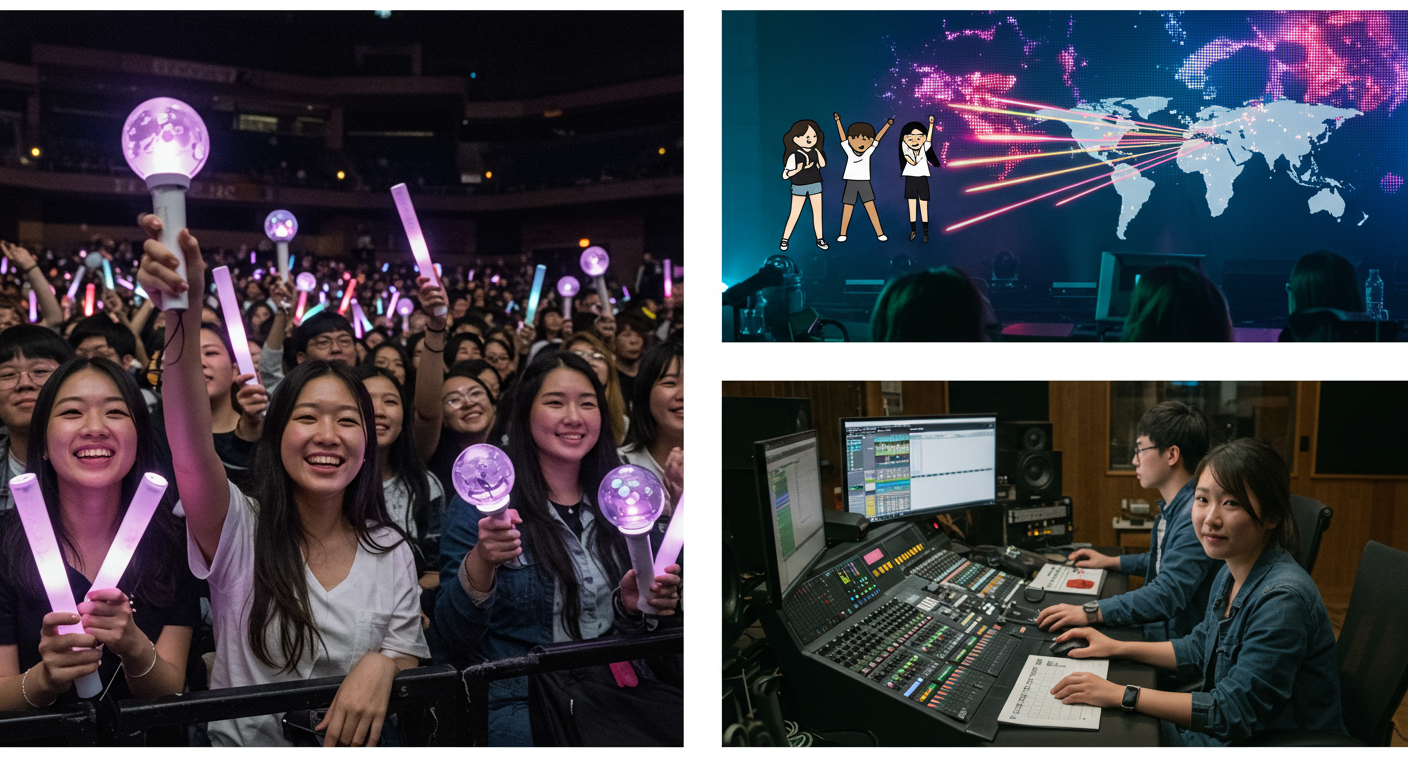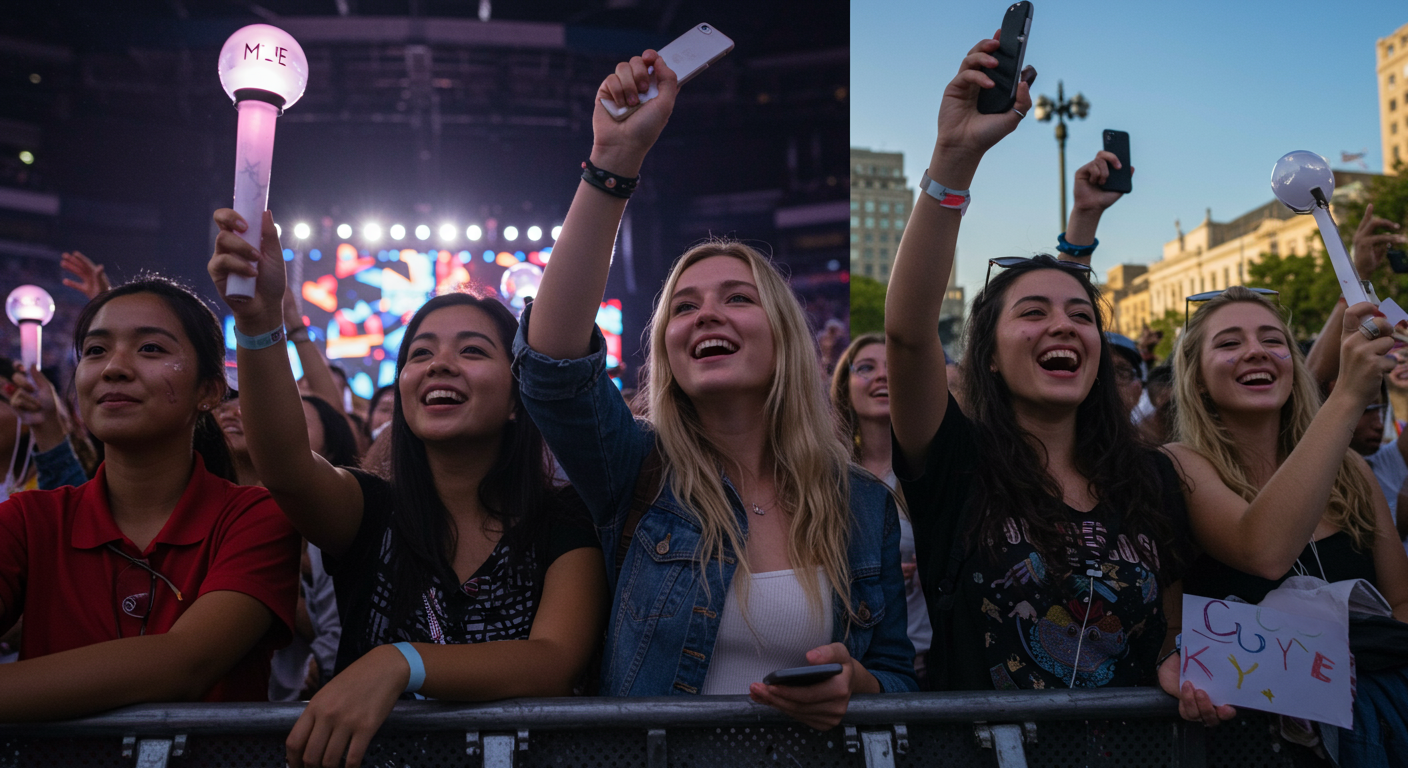Decoding K-Pop Fandom in the U.S.: Beyond the Hype
Decoding K-Pop Fandom in the U.S.: Beyond the Hype
Has K-pop taken over your playlist yet? Or maybe your kids are already deep into the fan chants and lightsticks? You're not alone, believe me.
For someone who's watched music trends ebb and flow for decades, the rise of K-pop in the U.S. has been nothing short of fascinating. It’s more than just catchy tunes and flashy videos; it's a global phenomenon built on incredible dedication, artistry, and an almost unbelievable connection between artists and their fans. Recently, Billboard delved into this very topic with a massive survey of American K-pop fans. The results? Well, they confirm what many of us have already suspected: this isn't just a fleeting trend. Let's unwrap what their findings tell us about the heart of K-pop fandom in the States, from the music to the communities that make it all tick.
 Description: "A vibrant, diverse group of young adults, aged 18-30, enthusiastically holding up K-pop lightsticks at a concert, their faces lit with joy and excitement. The background shows a dimly lit arena stage with a large LED screen displaying abstract, colorful patterns. Realistically styled photograph."
Description: "A vibrant, diverse group of young adults, aged 18-30, enthusiastically holding up K-pop lightsticks at a concert, their faces lit with joy and excitement. The background shows a dimly lit arena stage with a large LED screen displaying abstract, colorful patterns. Realistically styled photograph."
Table of Contents
The Unstoppable Rise of K-Pop in America
Remember when "Gangnam Style" exploded? That was just the tip of the iceberg, wasn't it? For years, K-pop was this vibrant, exciting world that felt almost exclusive to a devoted few outside Korea. Then, something shifted. Artists like BTS and BLACKPINK didn't just break into the U.S. market; they absolutely shattered it. Suddenly, you couldn't scroll through social media or turn on the radio without hearing about them. It was a cultural wave, no, a tsunami, that I frankly never saw coming with such force. Their meticulous training, synchronized choreography, and incredible storytelling resonated deeply with a global audience craving something fresh and authentic.
What makes K-pop so uniquely appealing to American audiences? Is it the sheer talent, the production quality, or something deeper? I think it's a blend of everything, including a meticulously built connection with fans that traditional Western music industries often overlook.
 Description: "A graphic illustration depicting the global spread of K-pop, with lines connecting South Korea to various continents, particularly highlighting a strong beam towards North America. Stylized figures representing diverse fans are shown around the U.S. map. A clean, infographic style."
Description: "A graphic illustration depicting the global spread of K-pop, with lines connecting South Korea to various continents, particularly highlighting a strong beam towards North America. Stylized figures representing diverse fans are shown around the U.S. map. A clean, infographic style."
What the Billboard Survey Reveals: Key Insights
Billboard's recent survey of 1,400 U.S. K-pop fans, aged 14 and above, provides some fascinating insights into this thriving community. It wasn't just about numbers; it was about understanding *who* these fans are and *how* they engage. What I found particularly interesting was the sheer diversity of the fanbase, transcending traditional age and demographic boundaries. While many assume it’s mostly Gen Z, the survey hinted at a broader appeal, with significant engagement across different age groups. It truly underscores how K-pop has managed to carve out a unique space in the American musical landscape.
The survey also shed light on how fans interact with the music and artists. It's not just passive listening. This community is incredibly active and dedicated. Here's a quick look at some key engagement methods:
| Engagement Method | Description | Impact on Fandom |
|---|---|---|
| Streaming & Buying Albums | Actively streaming music on platforms like Spotify/Apple Music and purchasing physical albums (often multiple copies). | Directly contributes to chart performance and artist revenue. |
| Concert & Tour Attendance | Traveling across states, lining up for hours, and actively participating in live performances. | Fosters community, creates memorable experiences, and generates significant revenue. |
| Social Media Engagement | Organized mass streaming, voting campaigns, hashtag trends, and fan-made content. | Drives global visibility, helps break records, and builds online communities. |
 Description: "A busy, modern recording studio control room with a young, diverse group of music producers and engineers (20s-30s, mixed genders) intently watching screens and working on audio mixing. The atmosphere is focused and collaborative. Realistic, documentary-style photograph."
Description: "A busy, modern recording studio control room with a young, diverse group of music producers and engineers (20s-30s, mixed genders) intently watching screens and working on audio mixing. The atmosphere is focused and collaborative. Realistic, documentary-style photograph."
Beyond the Music: The Power of Community and Connection
For K-pop fans, it’s not just about hitting play on a song. It’s about being part of something bigger. I remember seeing clips from My K-Festa's K-pop concert this year—the sheer energy, the coordinated lightstick ocean, the collective screams of joy. It was breathtaking! This shared experience creates a bond that transcends language barriers and geographical distances. These fans don't just listen; they engage, they celebrate, and they support their idols in ways that feel almost revolutionary in the music world. They create intricate fan theories, dedicate hours to learning choreographies, and even raise funds for charitable causes in their idols' names. It's a level of dedication that, honestly, leaves me pretty amazed sometimes.
So, what are the key elements fostering this incredibly deep fan engagement?
- Authenticity and Relatability: Despite their polished image, many K-pop idols share vulnerable moments, struggles, and growth journeys that fans deeply connect with.
- Interactive Content: From reality shows to live streams, fans get constant, unvarnished access to their idols' personalities and daily lives.
- Strong Storytelling: Music videos, albums, and entire group concepts often weave elaborate narratives that invite deep analysis and discussion.
- Community Building: Fandoms are highly organized, with fan leaders coordinating projects, charity drives, and social media campaigns, creating a powerful sense of belonging.
- Visual Appeal and Performance: Beyond just audio, the stunning visuals, intricate choreography, and high-quality production of K-pop are unparalleled.
 Description: "A close-up of a young woman's hands, possibly an early 20s college student, holding a brightly colored K-pop album, showcasing intricate details and vibrant artwork. Her expression is one of pure delight. The background is a soft-focus bedroom or living room setting. Soft, warm lighting, photo-realistic style."
Description: "A close-up of a young woman's hands, possibly an early 20s college student, holding a brightly colored K-pop album, showcasing intricate details and vibrant artwork. Her expression is one of pure delight. The background is a soft-focus bedroom or living room setting. Soft, warm lighting, photo-realistic style."
The Future Landscape: Where K-Pop is Heading in the U.S.
If Billboard's survey is any indication, K-pop's influence in the U.S. is not just stable; it's still growing, evolving, and digging its roots deeper into the American cultural soil. We're seeing more diverse artists, more collaborations with Western musicians, and an increasing presence on mainstream platforms. I mean, it’s not just music anymore, is it? It’s fashion, beauty, food—you name it. It's becoming a full-blown lifestyle brand for many. The challenge now, I think, is maintaining that unique connection and authenticity as it becomes more commercialized. Will the industry adapt to keep that special spark that makes K-pop, well, K-pop?
My guess? The fan devotion is too strong to simply fade away. Instead, we'll likely see K-pop continue to innovate, pushing boundaries and surprising us with new forms of engagement. It’s a dynamic ecosystem, and honestly, I can't wait to see what comes next.
Common Questions About K-Pop Fandom in the U.S.
Absolutely not! While K-Pop definitely has a strong appeal among younger demographics, Billboard's survey included fans aged 14 and above, indicating a significant portion of the fanbase is older. From what I’ve seen, the community is incredibly diverse, with fans spanning all age groups, backgrounds, and professions. It's truly a testament to K-Pop's universal appeal.
Beyond just listening to music, K-Pop fans engage through a multitude of channels. They stream music and videos religiously, purchase physical albums (often for collecting unique photocards!), attend concerts, and are highly active on social media. Many participate in fan-organized events, follow reality shows featuring their idols, and even engage in charity work in the groups' names. It's a very hands-on and immersive experience!
I think the biggest misconception is that it's a passing fad or just "pop music with an Asian twist." K-Pop is a highly sophisticated, multi-faceted genre with deep roots in Korean culture and an incredibly rigorous training system for idols. It's also supported by a fandom that's arguably one of the most organized and passionate in the world. Its staying power and increasing global influence prove it's a significant cultural force here to stay, not just a trend.
What a journey it's been, watching K-pop capture the hearts of so many in America. From its nascent stages to becoming a dominant force, the phenomenon is driven by an unparalleled bond between artists and their dedicated fanbase. The Billboard survey really just scratches the surface of this vibrant, ever-evolving community. It highlights that K-pop isn't just about the music; it's about belonging, passion, and a shared cultural experience that continues to redefine global entertainment. And frankly, that's a beautiful thing to witness.